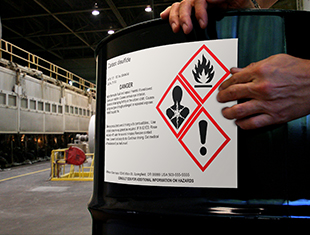Chemical Risk Assessments
03
February,
2023
4 MINUTE READ
Webinar | Chemical Risk Assessments
Chemical Risk Assessments
Protect workers from hazardous chemicals in five clear steps. You'll also:
- Pinpoint chemical risks in your facility
- Minimize hazards with the Hierarchy of Controls approach
- Get resources to make compliant chemical labels
 20:41 mins
20:41 mins Presented By

Brian McFadden
Technical Writer
Compliance Specialist
Related Resources
Transcript
Webinar Preview
Contents of the Chemical Risk Assessments Webinar:
- Understand the Rules
- Create a List
- Identify the Hazards
- Evaluate the Risks
- Assign Controls
- Document the Assessment
- Visual Communication for Chemical Safety
- Maintaining and Managing Chemical Safety
Excerpt from the Chemical Risk Assessments Webinar transcript:
Understand the Rules
Before you jump into an assessment, you need some preparation. The first step here is identifying and understanding the specific rules that apply in your circumstances.
Some of the most important guidelines for talking about chemical hazards come from the Globally Harmonized System of Classification and Labeling of Chemicals, or more simply, GHS. This international standard is maintained by the United Nations, and it offers a consistent and comprehensive way to describe many of the dangers that could be posed by a chemical. The GHS approach also includes standardized labeling and documentation for chemicals, which will be very helpful in the later steps of the Chemical Risk Assessment. If you're not already familiar with the GHS approach, take a look at our free guide to GHS, available online.
Once you have that foundation, you're ready for the legal requirements. In the United States, there are different rules that may come into play, depending on what the material is, and where it is. For example:
. Hazardous chemicals in a workplace are generally covered by OSHA's workplace safety regulations. One of OSHA's most important rules here is the Hazard Communication Standard (or HazCom) - which is based on GHS.
. Hazardous chemicals that are being transported from one facility to another will probably be covered by rules from the Department of Transportation (or DOT).
. If you produce chemicals as consumer products, then they need to be labeled and packaged according to the rules from the Consumer Product Safety Commission (or CPSC).
. For cosmetics, pharmaceuticals, and food ingredients, the Food and Drug Administration (or FDA) takes over.
. For waste chemicals, like expended solvents, the Environmental Protection Agency (or EPA) will have governing regulations.
In addition to these federal rules, state or local regulations may also apply. In many cases, there are rules that apply to specific chemicals or hazards. For example, OSHA has many material-specific rules (mostly in 29 CFR section 1910, subparts H and Z).
Of course, outside the United States, other countries' laws will be more relevant; there may even be international rules to consider. If your chemicals are going to Europe, for example, then a series of European Union regulations will probably be involved, including REACH and CLP. These rules often call back to the GHS approach, so that foundation will be very helpful for international compliance.
Create a List
Once you've identified any specific rules you need to follow, the next step is to figure out what materials you're working with. Essentially, you're making a list.
This may include:
. raw materials,
. process supplies, like lubricants,
. cleaning supplies and solvents,
. your facility's actual products,
. and any wastes or garbage that might need special handling.
OSHA's HazCom rule requires each facility to maintain a list of all the hazardous chemicals that are present there. This same list can also include practical details such as what the material is used for, and where it's stored, making it a useful reference for the future, as well as a part of your risk assessment process and compliance efforts.
Be sure that your list clearly identifies each chemical. Many materials are known by multiple names; for example, methyl ethyl ketone (or MEK) is also called "ethyl methyl ketone," "butanone," and "methylacetone." Some workers may be familiar with one name, but not another. OSHA requires a facility's chemical list to include the same name, or Product Identifier, that is used on the chemical's Safety Data Sheet, or SDS.
Identify the Hazards
Once you have your list of materials, you can identify the individual hazards that may be posed by each item on that list. For the purpose of a risk assessment, a "hazard" is any potential cause of injury or loss. Chemical hazards specifically arise from a chemical's intrinsic attributes, like flammability or toxicity.
There are many different ways to identify chemical hazards. If the rules that apply to your situation call for a specific system of identifying hazards, be sure to use that system. A common general approach is used in GHS, which gives standardized names and definitions for a wide variety of chemical hazards. OSHA's HazCom rules use the GHS approach with some modifications.
In most cases, chemicals and their hazards should be documented with a Safety Data Sheet, or SDS. This document will be very helpful in your Chemical Risk Assessment process.
. If your chemicals come with an SDS from the supplier, that document will include descriptions of the hazards of the chemical, along with other helpful information, such as recommended precautionary measures.
. If you purchase chemicals that don't come with an SDS, you can usually get a free copy of the document by contacting your supplier directly. Often, you can even find an SDS by searching online for the name of the supplier, the name of the chemical, and the term "SDS."
. If your facility produces the chemical in question, you may need to produce an SDS for it as well, in order to comply with regulatory requirements or industry standards. If your company acts as a chemical supplier, it's especially important to follow the Chemical Risk Assessment process.
Evaluate the Risks
Even when two chemical hazards are similar, different circumstances can lead to widely different levels of danger. This is where the term "risk" is important. While a "hazard" is simply any potential source of injury or harm, "risk" combines two ideas: how likely a harmful event is, and how severe its outcome would be.
To effectively assess the risk of a situation, take a step-by-step approach. First, consider the likelihood of harm resulting from a given hazard:
. How frequently would someone use the chemical, or otherwise have a chance of exposure to the hazard?
. How likely is it that a given use or exposure would result in a harmful event?
. How difficult would it be for a person to avoid injury if that harmful event occurred?
Then, consider the severity of harm that could result. Think of the worst-case result that could reasonably be caused by the hazard:
. Could someone die, or be permanently injured?
. Would injuries require hospitalization, or would they only require first aid?
. Would property damage or interrupted productivity be important outcomes?
Combining these two areas - the likelihood and the severity of harm - gives you the overall risk. Situations or materials that pose more serious overall risks will need to be prioritized.
The process of evaluating risks benefits from a systematic approach. Our Best Practice Guide for Chemical Risk Assessments, available online, includes a scoring system that may be helpful for your facility.
To learn the about common types of visual signals, and practical guidance on maximizing the value of visuals in your facility, watch the full webinar on demand now!
RELATED RESOURCES

GHS & HazCom for Chemical Safety
Webinar | GHS & HazCom for Chemical Safety GHS & HazCom for Chemical Safety Maximize facility safety ...
Watch Now
Getting Started with your DuraLabel Printer
Webinar | Getting Started with your DuraLabel Printer Getting Started with your DuraLabel Printer Become an ...
Watch Now
Practical Pipe Marking
Webinar | Practical Pipe Marking Practical Pipe Marking Prepare your facility for safer, simpler, and more ...
Watch Now.png)


